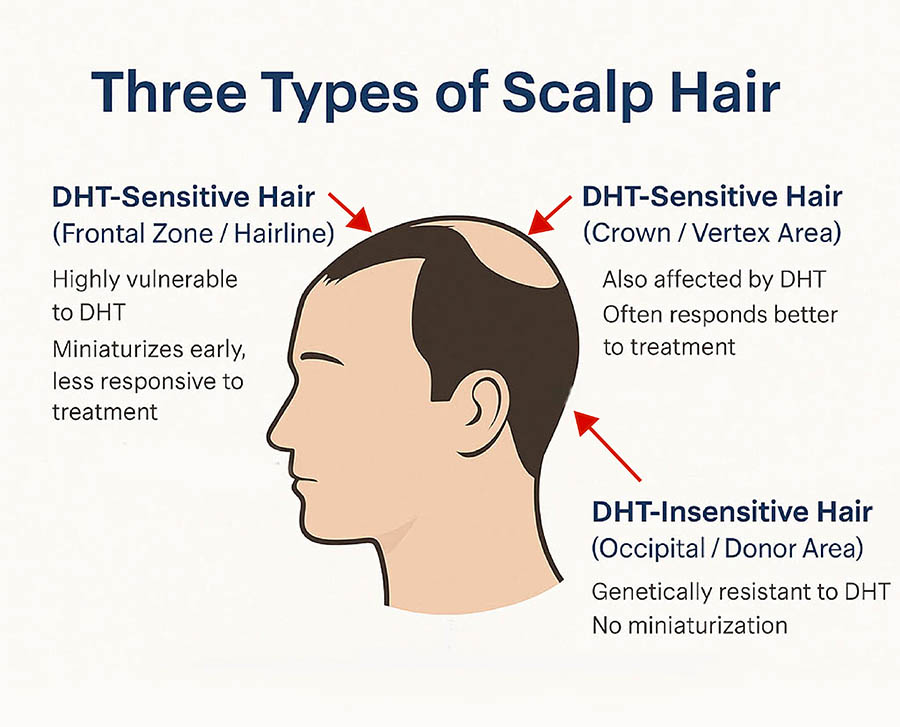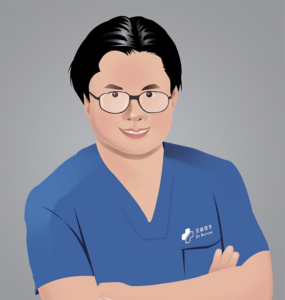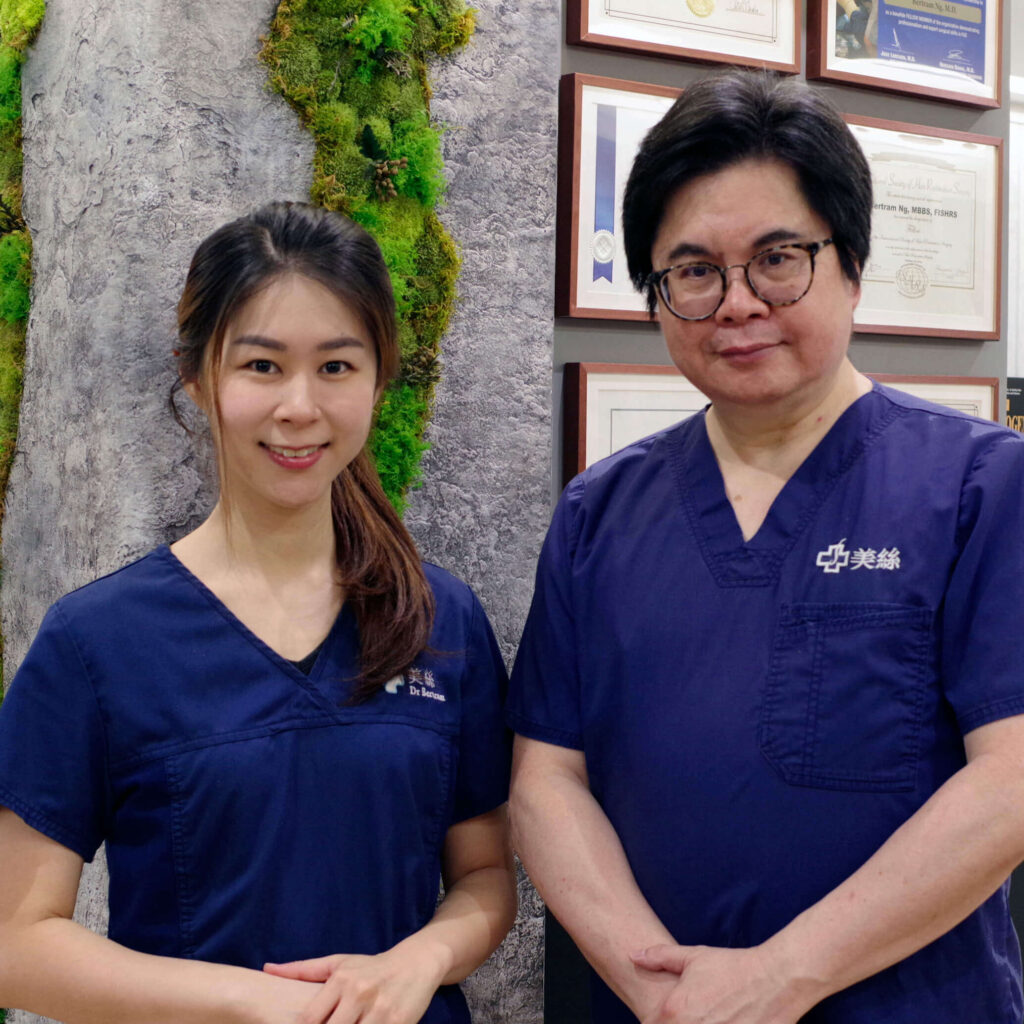- Hotline: 852+ 2891 9689
- Whatsapp: 852+ 9146 8426
- [email protected]
- 6/F 29 Austin Road, Tsimshatsui, Kowloon, Hong Kong
Dr. Norman Orentreich, an American dermatologist, in his 1952 introduced the concept of “donor dominance,” laying the groundwork for contemporary hair restoration techniques. Its later publication in 1959 has contributed to the emergence of a multibillion-dollar global hair transplant industry, offering lasting solutions for receding hairlines and firmly establishing hair transplant as a significant aspect of American culture. The followings are the updated scientific principles:
Traditionally, scalp hair was classified into two categories: DHT-sensitive and DHT-insensitive. However, clinical experience suggests a more accurate classification involves three distinct types, each with different characteristics and responses to treatment:

The cornerstone of modern hair transplantation has long been the Donor Dominance Theory. This principle holds that transplanted hair retains the characteristics of the donor site — such as color, curl, growth rate, and most importantly, resistance to DHT — even after relocation. This explains why there is no rejection, and why hair transplantation works so reliably.
However, advancements in the field have revealed a new layer to this understanding.
In the 2000s, Dr. Tommy Hwang (Korea) introduced the Recipient Dominance Theory. He observed that the recipient site can influence the behavior of the transplanted hair. For instance, scalp hair transplanted to the eyebrow tends to grow more slowly over time, gradually adopting the characteristics of the new location.
This breakthrough earned Dr. Hwang the ISHRS Gold Follicle Award, and reshaped how surgeons approach transplant planning — recognizing that both donor and recipient factors matter.
Not everyone experiencing hair loss is automatically suited for a hair transplant. The ideal candidate is someone with permanent hair loss, such as the followings, and has a sufficient supply of healthy donor hair at the back or sides of the scalp.
Hair transplant is most effective when guided by proper diagnosis and long-term planning. That’s why a comprehensive medical evaluation is essential before committing to surgery.
A good candidate typically:
Regardless of the technique—FUT, FUE, or ARTAS robotic harvesting—every hair transplant procedure follows the same three core steps. The main difference lies in Step 2: how the donor hair is harvested.
Local Anesthesia
The scalp is numbed to ensure a pain-free experience during the procedure.
Donor Harvesting
Permanent hair is removed from the donor area, typically the back or sides of the scalp.
In FUT, a thin strip of scalp is excised and dissected.
In FUE, individual follicular units are extracted directly from the scalp.
In ARTAS, a robotic system performs automated follicle extraction.
Graft Insertion
Using high-powered magnification, harvested grafts—each containing 1 to 4 hairs—are carefully implanted into the thinning or bald areas. Each graft is placed at the correct angle, direction, and spacing to preserve existing follicles and ensure natural-looking results.
Thanks to the use of tiny follicular unit grafts, today’s hair transplants produce soft, natural hairlines—a dramatic improvement over the unnatural “pluggy” results of older methods. At our clinic, we strategically combine single-hair grafts (for natural hairlines) and multi-hair grafts (for visual density) to achieve the most refined aesthetic outcome possible.
Hair transplant procedures generally take from 6-8 hours and are performed using local or twilight anesthesia on an out-patient basis. Patients are often awake but feel relaxed as they are given a mild sedative.
There is usually little or no pain during the surgical procedure. Nowadays no bandage is necessary on the scalp at the end of the procedure but a small head band will secure the donor to prevent swelling.
A hair transplant can be considered at almost any age, but timing is important.
It’s often ideal to start before becoming completely bald, as existing hair can help camouflage the transplanted area and enhance the overall result.
However, since hair loss is usually gradual and progressive, it may be unwise to start surgery too early—especially in very young patients whose hair pattern has not yet stabilized.
For men with mild to moderate hair loss, especially in the crown, medical treatments like Finasteride and Minoxidil may be recommended first to help preserve existing hair.
During your consultation, Dr. Ng will assess your condition and guide you toward the right timing and strategy based on your age, pattern of loss, and long-term goals.
Age is not a limiting factor — you are never too old for a hair transplant as long as you have a sufficient supply of healthy donor hair.
In fact, older patients often make excellent candidates because:
Whether you’re in your 50s, 60s, or beyond, what matters most is your overall health, donor hair availability, and your goals. Dr. Ng will assess all of these during your consultation to determine if you’re a good candidate.
The number would depend on 4 things:
1. The objective : whether to restore the hairline and add on density to thinning areas
2. The total area for transplant
3. The availability of donor hair
4. The Budget of the client
In Asian males about 3,200 to 3,600 hairs can be harvested in first session. Asian males have about 10,000 to 14,000 usable donor grafts per life time. In Caucasian males 4,200 to 5,400 grafts are readily available due to their higher donor density. We do not recommend overharvesting as some donor hair should be reserved for the future.
Depending on the degree of balding 1-2 procedures may be required. We do not rush to offer you a procedure. Considerations must be made regarding the number of grafts required, the area of potential alopecia, the safe donor supply, the textural characteristics of the patients hair, and the specific goals of the patient.
Technically yes—but practically no.
In 1972, Dr. Norman Orentreich reported that hair transplanted from one individual to another could survive for at least one year, provided that steroids were injected into the grafts every 30 days to prevent rejection.
However, this approach is not practical for long-term use. The ongoing use of immunosuppressive steroids carries significant risks and side effects, making it unsuitable for cosmetic procedures like hair restoration.
That’s why modern hair transplants always use your own hair, ensuring no rejection, no need for immune suppression, and long-lasting, natural results.
Donor hair is permanent but limited. Hair transplant only redistributes hair. It cannot change the progressive nature of AGA. The miniaturization of existing hair may offset the cosmetic results over years.
Hair transplants can be used to fill-in the front hairline and thicken the front half of the scalp, and medical treatments (Adjuvant Therapy) can be used to maintain existing hairs; in order to prolong the cosmetic results. A well trained hair transplant surgeon will work with their patients to design an individualized plan to fulfill their specific needs.
Not necessarily — a hospital may not be the safest place for a hair transplant.
Hospitals care for patients with all types of illnesses, including infectious diseases. Facilities, air systems, and equipment are shared, which increases the risk of cross-contamination. In fact, some of the worst wound infections we’ve seen occurred in hospital settings, including serious cases caused by MRSA (Methicillin-Resistant Staphylococcus Aureus) — a dangerous, antibiotic-resistant infection.
Hair transplant involves creating thousands of micro-wounds in the scalp. If one of these becomes infected, the consequences can be devastating. At our center, we treat only healthy, elective hair transplant patients in a controlled, dedicated environment. We follow strict sterilization protocols. As the procedure is done under local anesthesia, there’s no need for hospital admission. For safety, precision, and peace of mind,
A specialized hair transplant clinic is often the better choice

Hair transplant is not the same as Artificial or Synethetic Hair Transplant. Transplanting your own hair is the only permanent solutions to hair loss.

From consultation, surgery, to aftercare, you will receive continued personal care by our doctors, not just consultants.
Have a question? Please feel free to call our friendly customer service.
International Accreditations
Recognized by leading global medical bodies, our clinic stands as one of the most qualified and internationally accredited hair transplant centers in Hong Kong and mainland China. We are proud to uphold the highest standards in medical ethics, safety, and surgical expertise.
Hair transplant is the ultimate solution to restores hair, but not everyone is good candidate.
Our online assessment helps determine if these procedures suit you, saving you time and costs.